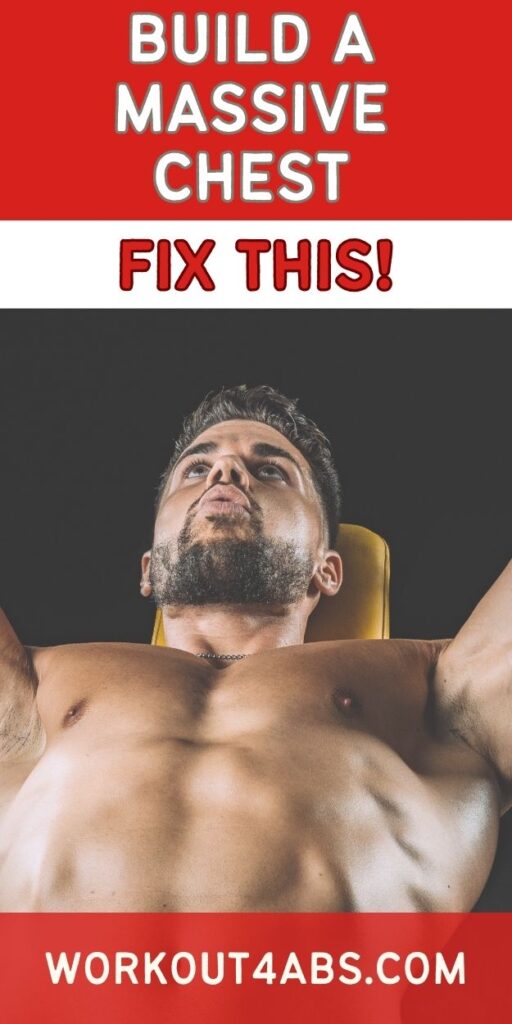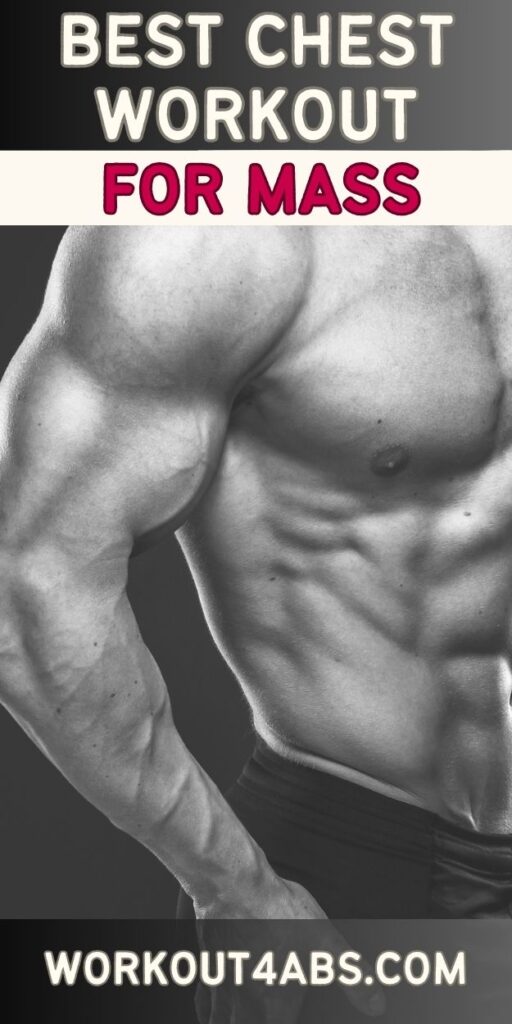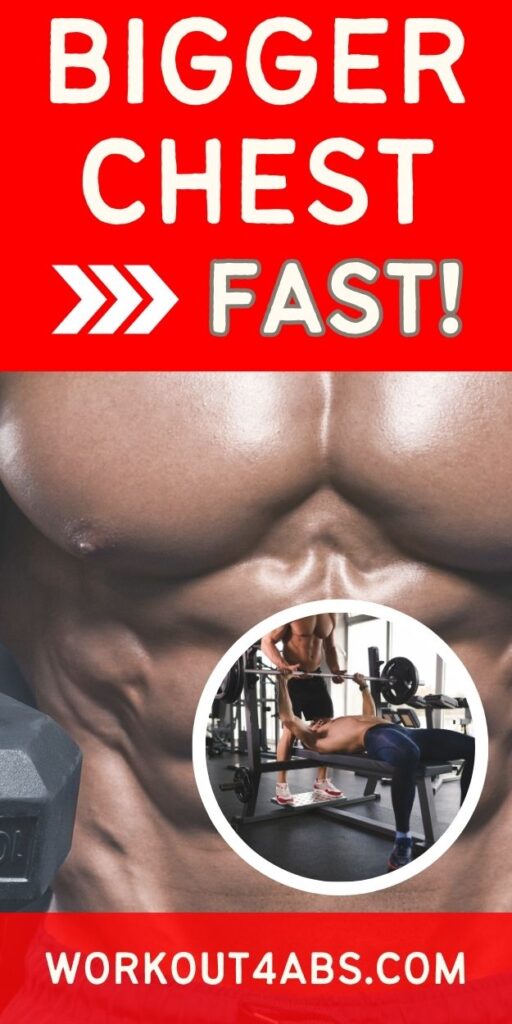Are you ready for a bodybuilding chest workout for building a large sculpted chest? Here, we delve into a simple routine designed to build significant chest muscle strength and size. Discover the exercises, techniques, and tips that will help you achieve your goal of a big, powerful chest.
Chris Bumstead’s Chest Workout
If you enjoyed these tips, please save this pin to your Pinterest Board.

Cable Chest Fly Warm Up
The cable chest fly is an excellent warm-up exercise to activate and prepare your chest muscles before a more intense chest workout. It’s important to perform this exercise with proper form and gradually increase the weight to avoid injury and maximize its effectiveness. Here’s a step-by-step guide on how to do cable chest fly exercises, starting from a high point and progressively lowering the attachment point for each set while adding weight:
Equipment Needed:
- Cable machine with adjustable pulleys
- D-handles or single-hand attachments
- Bench (optional)
Starting from a High Point:
1. Set Up: a. Adjust the pulleys on the cable machine to the highest position. b. Attach D-handles or single-hand attachments to both pulleys. c. Stand in the center of the cable machine, feet shoulder-width apart. d. Hold one handle in each hand, palms facing forward. e. Take a step forward and create tension in the cables. Your arms should be slightly bent and your body should be upright.
2. Warm-Up Set (Light Weight): a. Perform a light warm-up set with a weight that is easy to handle. b. Keep your elbows slightly bent and maintain a slight bend in your knees. c. Open your arms wide, bringing them out to your sides in a controlled motion. d. Squeeze your chest muscles at the peak of the movement. e. Slowly return to the starting position, feeling a stretch in your chest.
3. Proper Form: a. Maintain a slight arch in your lower back and keep your core engaged. b. Avoid bending your elbows too much during the movement. c. Keep your shoulders down and back. d. Focus on using your chest muscles to move the weight, not your arms.
Starting at a Lower Point for Each Set:
4. Set #2 (Mid-Point): a. Lower the pulleys to a mid-level position. b. Increase the weight slightly, still maintaining good form. c. Perform another set of chest fly exercises.
5. Set #3 (Low Point): a. Lower the pulleys to the lowest position. b. Increase the weight again, ensuring it challenges your chest muscles. c. Perform your final set of cable chest fly exercises.
Adding Weight to Each Set:
To add weight for each set, simply adjust the weight stack on the cable machine. Most machines have a pin or a selector where you can increase or decrease the weight in small increments.
Additional Tips:
- Perform each set for 10-15 repetitions with controlled movements.
- Focus on the mind-muscle connection and the stretch and contraction of your chest.
- Maintain proper breathing throughout the exercise, exhaling as you bring the handles together.
- Always prioritize good form over heavy weights, especially during a warm-up.
Remember, this warm-up exercise is meant to prepare your chest muscles and joints for more intense exercises, so start with a lighter weight and gradually increase it as you progress through your sets. Always consult a fitness professional or trainer if you’re unsure about your form or technique.
Barbell Flat Press
The barbell flat bench press is a fundamental compound exercise that primarily targets the pectoral muscles (chest). It’s an excellent exercise for building chest strength and size, and while genetics can play a role in muscle development, hard work and proper training can make a significant difference. Here’s a step-by-step guide on how to perform the barbell flat bench press:
Equipment Needed:
- Barbell
- Bench
- Weight plates
- Collars (to secure the weights)
Execution:
- Setup: a. Begin by lying flat on your back on a bench. Make sure your head, shoulders, and buttocks are in contact with the bench. Your feet should be flat on the ground. b. Position yourself so that your eyes are aligned with the barbell. Ensure that the barbell is securely racked above you. c. Grasp the barbell with a grip slightly wider than shoulder-width apart. Your palms should be facing forward (overhand grip). d. Lift the barbell off the rack and hold it directly above your chest with your arms fully extended. This is your starting position.
- Descent: a. Inhale deeply, brace your core, and lower the barbell in a controlled manner to your chest. Keep your elbows at a 45-degree angle to your body. The barbell should touch your chest lightly or come very close. b. Maintain a slight arch in your lower back, and your shoulder blades should be pulled back and down to create stability and support.
- Ascent: a. Exhale forcefully and press the barbell back up to the starting position, fully extending your arms. Focus on using your chest muscles to push the weight.
- Repetitions: a. Perform your desired number of repetitions. Typically, for muscle growth (hypertrophy), aim for 8-12 reps per set. b. Once you’ve completed your set, carefully rack the barbell back onto the rack.
Tips:
- Maintain a controlled tempo throughout the exercise. Avoid bouncing the bar off your chest.
- Keep your wrists straight to avoid unnecessary strain on your joints.
- Use a spotter, especially when lifting heavy weights, to ensure safety and help with unracking and racking the barbell.
- Focus on progressive overload by gradually increasing the weight you lift over time. This is important for building muscle.
Regarding genetics and muscle development, it’s true that some individuals may have genetic advantages in terms of muscle size and potential, but hard work, consistency, and proper training can help anyone make significant gains in muscle size and strength. Lifting heavier weights, combined with proper nutrition and recovery, is a key factor in promoting muscle growth, even for those who may not have the genetic predisposition for a naturally large chest.
Remember that individual results may vary, and it’s essential to consult with a fitness professional or trainer to create a personalized workout plan that aligns with your goals and genetic potential. Additionally, prioritize a well-balanced workout routine that includes exercises targeting all major muscle groups, not just the chest, for overall strength and aesthetics.
If you enjoyed these tips, please save this pin to your Pinterest Board.

Incline Dumbbell Press
The dumbbell incline press is an effective exercise for targeting the upper chest muscles and building overall chest strength and size. Here’s a step-by-step guide on how to perform the dumbbell incline press properly:
Equipment Needed:
- Incline bench (adjustable to a 30-45 degree angle)
- Dumbbells of an appropriate weight
- Collars (to secure the dumbbells)
Execution:
- Setup: a. Adjust the incline bench to your desired angle, typically between 30 to 45 degrees. A steeper angle focuses more on the upper chest. b. Sit down on the incline bench and position your back firmly against the backrest. c. Plant your feet flat on the floor for stability. d. Grab a dumbbell in each hand using a neutral (palms facing each other) grip.
- Starting Position: a. With the dumbbells in hand, lift them one at a time, or have a spotter hand them to you, and position them directly above your chest. Your arms should be fully extended, and your palms should be facing forward. b. Your wrists should be straight, and your elbows should have a slight bend to reduce stress on the joints. c. This is your starting position.
- Descent: a. Inhale deeply and lower the dumbbells slowly and under control towards your chest. Keep your elbows at about a 45-degree angle to your body. b. Allow the dumbbells to come down until your elbows are slightly below the level of the bench or until you feel a stretch in your chest.
- Ascent: a. Exhale forcefully and press the dumbbells back up to the starting position, fully extending your arms. Focus on using your chest muscles to push the weight. b. Squeeze your chest muscles at the top of the movement for an extra contraction.
- Repetitions: a. Perform your desired number of repetitions. For muscle building (hypertrophy), aim for 8-12 reps per set. b. Once you’ve completed your set, carefully lower the dumbbells back to the sides of your chest.
Tips:
- Maintain a controlled tempo throughout the exercise, avoiding bouncing the dumbbells off your chest.
- Keep your shoulder blades pulled back and down to maintain stability and support.
- Use a spotter, especially when lifting heavy weights, for safety and help with handing you the dumbbells.
- Focus on progressive overload by gradually increasing the weight you lift over time to stimulate muscle growth.
Incorporating the dumbbell incline press into your chest workout routine can help you target the upper chest effectively, adding depth and size to your chest muscles. Combine it with other chest exercises, like flat bench presses and flyes, to ensure you are working all areas of your chest for a well-rounded chest development.
Supersetting the Machine Pec Deck with Decline Hammer Press
Supersets are a great way to intensify your workout by performing two exercises back-to-back with little to no rest in between. In this superset, you’ll be using the Machine Pec Deck to pre-exhaust your chest muscles before moving on to the Decline Hammer Press to maximize muscle engagement. Here’s how to perform this superset:
1. Machine Pec Deck (Pre-Exhaust):
Setup: a. Adjust the seat on the Machine Pec Deck so that the handles are at chest height or slightly below. b. Sit down on the machine with your back flat against the backrest. c. Grasp the handles with your palms facing each other, and your elbows bent at about 90 degrees. d. Keep your feet flat on the floor for stability.
Execution: a. Begin by squeezing your chest muscles and pushing the handles together in front of you. b. Exhale as you bring the handles together and contract your chest muscles. c. Hold the contraction for a second to maximize the muscle engagement. d. Inhale as you slowly return the handles to the starting position, feeling a stretch in your chest. e. Perform 10-15 repetitions with a moderate weight to pre-exhaust your chest muscles. Rest briefly (about 30 seconds) before moving on to the next exercise.
2. Decline Hammer Press (Compound Movement):
Setup: a. Locate a Decline Hammer Press machine in your gym. b. Adjust the seat and handles to a comfortable starting position. c. Sit down on the machine with your back flat against the backrest. d. Grasp the handles with a neutral (palms facing each other) grip.
Execution: a. Begin by pushing the handles away from your chest while extending your arms fully. b. Exhale as you press the handles forward, engaging your chest muscles. c. Hold the contraction for a moment at the fully extended position. d. Inhale as you slowly return the handles to the starting position, maintaining control throughout the movement. e. Perform 8-12 repetitions with a challenging weight.
Superset Protocol: a. After completing the pre-exhaust set on the Machine Pec Deck, immediately move to the Decline Hammer Press machine without resting. b. Perform the Decline Hammer Press set. c. Rest for 60-90 seconds between supersets. d. Repeat the superset for the desired number of sets (typically 3-4 sets).
Tips:
- Use proper form and control for each exercise to maximize muscle engagement and minimize the risk of injury.
- Choose weights that challenge you but allow you to maintain good form throughout the sets.
- Focus on mind-muscle connection to feel the chest muscles working during each repetition.
By pre-exhausting your chest muscles with the Machine Pec Deck before moving on to the compound movement of the Decline Hammer Press, you’ll target your chest from different angles and intensify the muscle recruitment, which can lead to better muscle growth and definition.
If you enjoyed these tips, please save this pin to your Pinterest Board.

Home › Chest Exercises ›Bodybuilding Chest Workout